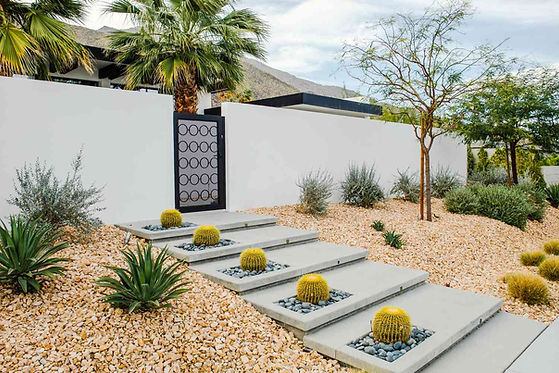
Sanctuary School & Studio
Welcome to our School & Studio! Where you can Learn "how It's Done" and pick out options via our studio below within the sub service you have selected to view:
-
School: Knowledge on how the sub-service is done.
-
Studio: Options on all materials/colors for selected sub-service.
What is softscaping (aka. Gravel, Pebbles, & Rocks) & It's Applications?
- Softscaping goes beyond just plants and trees. It also encompasses the creative use of inorganic materials like gravel, pebbles, and rocks to enhance the beauty and functionality of your outdoor spaces. These versatile materials can be used in a variety of applications throughout your property. Picture a dry creek bed winding through your garden in Mission Viejo, created with smooth river rocks and accented with drought-tolerant plants. Or envision a patio in Yorba Linda featuring a decorative gravel border that adds texture and visual interest. From creating pathways and walkways to mulching garden beds and accenting water features, the possibilities with gravel, pebbles, and rocks are endless. Sanctuary Design & Build can help you incorporate these elements into your landscape design, creating a unique and inviting outdoor oasis in your Orange County home.

1
School
Our official "How It's Done" section to help educate our clients to understand our industry leading installation process!
Course: HOW IS SOFTSCAPING INSTALLED?
Process - Gravel & Pebble Installation (All loose fill materials)
Discover our step by step guide on how we bring your softscape projects to life. Unless otherwise stated in your contract, all installations pertaining to Gravel, pebbles, or any rocks are performed in the exact outlined method!


Phase 1: Demolition & Prep
The initial stage to any properly done softscape project is a strong foundation, demolition and preparation to mark the layout of the project and to compact the bedrock before the next phases are paramount to a long lasting and properly done project. During this stage we typically remove 2-4" of dirt or surface and level to grade the drainage properly. After grading and demolition is complete compacting will begin to complete the prep stage.

Phase 2: Premium Fabric
To ensure your new gravel landscape will last we will next install a premium geotextile fabric and secure said fabric into place properly. This is to ensure that weeds or growth from the sediment below will not impact your new landscape space and will result in a longer lasting project both aesthetically and functionally. Proper installation of this fabric is paramount as improperly securing the fabric will result in failure down the road.

Phase 3: Base Preparation
In used spaces such as pathways or heavier traffic areas we will utilize a base layer of crushed rocks and compact this layer, and level, to create a stronger base that wont shift or pull apart after many years of usage. A plate compactor or roller compactor will be used to follow the same grade that was done during phase 1 to retain the consistency from the initial stage.

Phase 4: Edging (Optional)
Edging is sometimes needed prior to the installation of the gravel. This is needed when the parameter of the space you are installing the gravel does not have a natural restraint such as an attached concrete pad, any other structures, etc... In these instances the edging is used to retain the gravel within the work area.
TO VIEW OUR EDGING OPTIONS PLEASE VISIT OUR EDGING PAGE BY CLICKING HERE.

Phase 5: Loose Fill Installation
We start by evenly spreading the loose fill over the prepared base, ensuring a uniform layer. We'll Use a rake to level the rocks, filling in any low spots for an even surface. For optimal drainage and aesthetics, we aim for a depth of about 2 to 4 inches however your contract will state exactly how deep depending on the loose fill material picked. Finally, we compact the gravel using a plate compactor to secure it in place, reducing the risk shifting and creating a stable, attractive surface for your outdoor space.

2
Studio
Our Official Studio will guide you through all options we carry within the selected category to expertly guide you in your decision making process!
Studio Display: Our Collections of Gravel, Pebbles, & Rocks.
Let's Pick Out Your Softscape Material!
Please review our list of available softscape materials, all selections below are available and can be used for any application however be wary of the sizes offered as some sizes may not be best fit for certain uses. Please speak with a representative for guidance on what is best for your project.
Pebbles & River Rocks
Pebbles and river rocks are naturally occurring stones that have been shaped by the flow of water over time. Pebbles are typically smaller, smooth stones that can range in size from a few millimeters to a few centimeters, while river rocks are larger, often more irregularly shaped stones found along riverbeds. Both are commonly used in landscaping, gardening, and decorative features due to their aesthetic appeal and durability. Their varied colors and textures can enhance the visual interest of outdoor spaces.

Gravels & Rocks
Gravel and crushed rocks originate from natural and mechanical sources. Weathering and erosion of larger rocks over time can create gravel which is typically sourced from riverbeds & glacial deposits where it is naturally rounded by water movement. Crushed rocks, on the other hand, are produced by mechanically breaking down larger stones into smaller fragments, often involving heavy machinery. Both materials come in various sizes and colors, reflecting their geological origins, and they play a crucial role in creating a beautiful landscape in any residential application.

Lava Rock Selection
Lava rocks, also known as volcanic rocks, are from the magma that erupts from a volcano and cools rapidly upon exposure to air or water. This cooling process creates a porous and lightweight rock with a unique texture. Lava rocks are commonly used in, gardening, and construction due to their and aesthetic appeal. They can also serve as excellent drainage material, provide insulation in fire pits, and even be used in various artistic projects.

Mini Pebbles & Rocks
Mini pebbles are charming little stones that can really elevate your space. These smooth, colorful pebbles are perfect for adding a touch of natural beauty to your garden or yard. You can use them as cover, in flower beds, or along pathways to help with drainage and keep weeds at bay. Plus, they bring a lovely texture and variety to your landscaping, making it feel more inviting and relaxed.

Decomposed Granite (DG)
Decomposed granite is a natural material made up of tiny granite particles, giving it a texture similar to coarse sand. Its durability and visual charm make it a popular choice for residential landscaping. Many homeowners use decomposed granite for creating pathways, driveways, and patios, as it offers excellent drainage. Moreover, its earthy hues can elevate the beauty of gardens and outdoor areas, appealing to those aiming for an attractive and practical landscape.

%20whi.png)
























